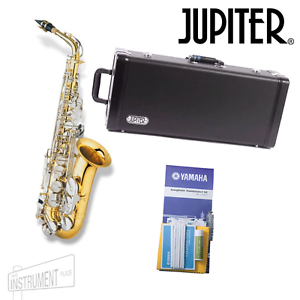Introduction
Although the Saxophone is made of brass, it is classified as a woodwind instrument and utilizes a mouthpiece resembling that of the clarinet.
Starting in the mid-1920s with the rise of the big bands, the saxophone family slowly but steadily evolved from a vaudeville novelty into a staple in the mainstream of jazz. The saxophone family includes instruments with at least eight different voice ranges: soprano, alto, tenor and baritone being the most common. Since they were patented in 1846, saxophones have become centrally important in military, dance and jazz bands. Today, the tenor and alto saxophones are the most favored instruments for sax players.
Why Play the Saxophone
A saxophone for a child is a great starting point for learning music. The saxophone is perhaps the most widely heard solo instrument of the wind family in popular and jazz music – just like the violin is the most popular string instrument. It has a singing quality with a rich middle register, commanding low register, and an exciting and colorful extended range.
Also, unlike the flute and clarinet, the saxophone is very accommodating in the early stages of musical development. Within the standard range, notes respond easily, even with the most undeveloped embouchure. The saxophone is not as prone to “squeak” like the clarinet or sound airy and flat like the flute in the beginning. To be successful, attention needs be given to the development of good posture, support, relaxation, hand position, breathing, embouchure, articulation, and manual dexterity. The best saxophone price is still a bit higher than a student flute or clarinet price – but still affordable.
How to Play the Saxophone
Below is a video series introducing the parts of the saxophone and how to get started.
How to Assemble the Saxophone
How to Hold the Saxophone
How to Put on a Saxophone Reed
How to Play Your First Note on the Saxophone
How to Tongue on the Saxophone
Which Saxophone Should I Choose?
The Orchestra Place requires all students to have an instrument from the teacher-approved brand list to ensure the best experience and sound for the student and the ensemble.
For beginners, we recommend the Jupiter Student Alto Saxophone as the best alto saxophone for quality and affordability.
Jupiter JAS700 Student Eb Alto Saxophone
The Jupiter Student Alto Saxophones has a lacquered brass body and keys, high F key, tilting G# – Bb table keys, upper and lower stack adjusting screws, metal tone boosters and adjustable thumb rest. These student saxophones are crafted from the highest quality materials to meet the demands of all student players in terms of both durability and artistry, and is now extremely professional looking with the entirely gold lacquered finish.
The traditional starting place for the beginning saxophonist is with the alto saxophone. This is in part due to the fact that that vast majority of classical saxophone literature is written for the alto. Additionally, the alto requires slightly less air than does the tenor, and the smaller key scale often fits more comfortably in a young person’s hands.
Further, the angle of air flow as well as the embouchure required to play alto is very much transferable to all of the saxophones. These points do not, however, preclude a beginner from starting on tenor or baritone saxophone. With proper guidance, repertoire and technique can be adapted to all of the saxophones.
Back to topHow to Buy a Saxophone
After a young saxophone player has at least a year of experience, buying an instrument is often the best choice, both financially and in sense of ownership. Your student has demonstrated their commitment and is ready to maintain and practice on their very own instrument. Since purchasing a saxophone is a bigger investment than renting, it’s important to make sure you’ve carefully compared retailers’ inventory, prices, financing options, setup and equipment options prior to buying. If and when you are ready to commit and invest in purchasing a saxophone, keep in mind the following guidelines and tips.
Stick with well-known brands when shopping. A quality saxophone will have a lacquered brass body, durable screws, an adjustable thumb rest, and nickel plated keys.
Back to topHow Much Should a Saxophone Cost?
An alto saxophone will range from $1000 to $3000 or more. A tenor saxophone will cost roughly $1,500 to $3000 or more.
Back to topRent-to-Own or Lease-to-Own Saxophone Options
Installment plans are an excellent option if you’re ready to make the commitment of buying an instrument but can benefit from deferred payments. This way, you get the freedom to pay over time, with the ultimate reward of owning the instrument. If you choose a rent-to-own or lease-to-own option, however, it’s important to check the fine print to make sure there are no hidden fees, and you should investigate the cancellation policy as well. Never sign up for a plan that traps you into payments if your child loses interest in playing an instrument. Look also for retailers who offer affordable damage protection during the installment term.
Our instrument supplier, The Instrument Place, offers teacher-approved instruments and one of the best interest-free lease-to-own programs as part of their commitment to getting an instrument in the hands of every person who wishes to play, without it being a financial burden.
Back to topRecommended Saxophone Accessories
When buying a saxophone, look for a store that offers all the accessories your child will need in order to best use and maintain it. Along with your purchase, check that a protective case and care kit are included or can be added. The care kit should include a cleaning cloth to remove excess oil and grease from the outside of the saxophone, valve oil or spray to lubricate the valves, and a name tag. Some other items you could also pick up are a cleaning snake, mouthpiece brush, and tuning slide grease.
If given the option to purchase a music stand, go for it! A music stand promotes proper playing posture, which helps to prevent back aches and hunching over.
The Instrument Place instrument outfits come equipped with everything needed to get started in class, plus a free music stand with every instrument purchase!
Back to topSaxophone Maintenance and Care
Assembly
- Always consult your teacher if you are not sure how to put together your instrument.
- NEVER force the parts of your instrument together.
- Hold on to the bell and neck when attaching the neck to the body.
- To avoid bending the neck, hold on to the neck when attaching the mouthpiece to the neck assembly.
- Avoid holding the keys when assembling your saxophone.
Maintenance
- Every saxophone player should have a maintenance and care kit.
- Use cork grease on your saxophone as little as possible.
- When you do apply cork grease you will need to rub it into the cork. When properly used, cork grease should allow you to assemble your saxophone without using excessive force.
- Do not leave the reed attached to the mouthpiece. This will shorten the life of the reed and cause it to collect germs.
- Wipe off your fingerprints from the keys after every use. A clean, non-treated cotton cloth will work the best. If you do choose to use a treated polishing cloth be sure that it is for the proper finish. Using the wrong treated cloth could cause scratches.
- Clean out the moisture from your instrument with an absorbent cotton drop swab after every use by inserting it in the small end first. Removing the moisture from your saxophone before putting it away each time will prolong the life of the pads.
- Please do not leave your neck strap attached to your instrument while in the case.
- Always store your instrument in its case with the lid closed when not in use. This will prevent any excess tarnishing and lower the risk of damage.
- Do not put anything (including sheet music) inside the case with your instrument that does not belong. Closing the case with extra contents can cause damage to the delicate keys.
- Also, make sure that all the latches are securely closed before transporting your instrument.
Student saxophone prices can be considerable so take care of your instrument.
Back to topFamous Saxophone Players
The saxophone is thought of as mostly a jazz and big band instrument, but it is heard prominently in orchestral music and popular music as well.
Famous classical saxophone players include Daniel Kientzy, Claude Delangle, John Harle, Vincent David, Fred Hemke, Arno Bornkamp, Otis Murphy, Kenneth Tse, John Edward Kelly, Eugene Rousseau and Daniel Gauthier.
Well known jazz saxophone players include Charlie Parker, Sonny Rollins, Julian “Cannonball” Adderley, Kenny G., John Coltrane, Grover Washington Jr., Stan Getz, Eric Dolphy and Wayne Shorter.
In rock and pop music, top saxophone players include Clarence Clemons and Dick Perry.
Back to top
